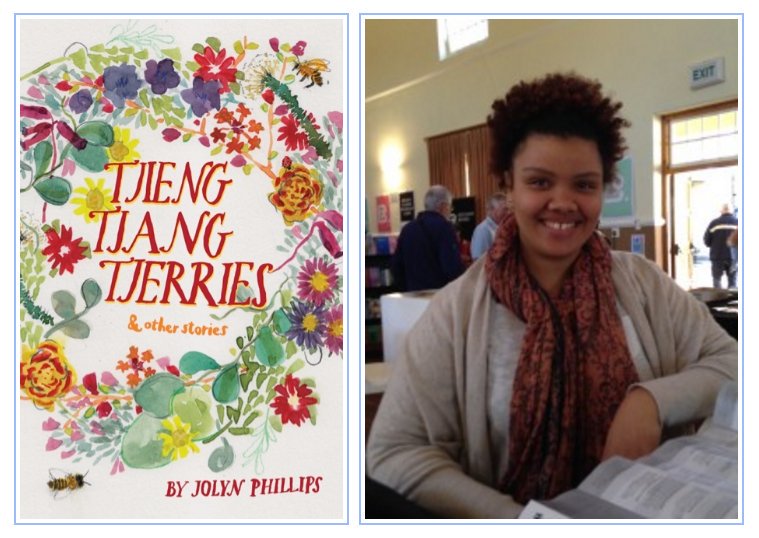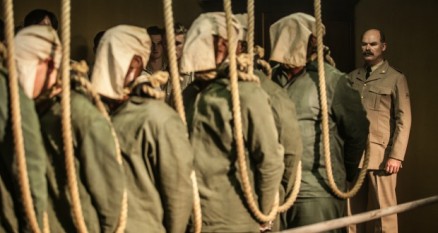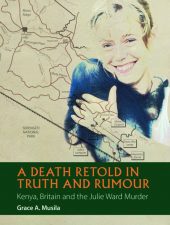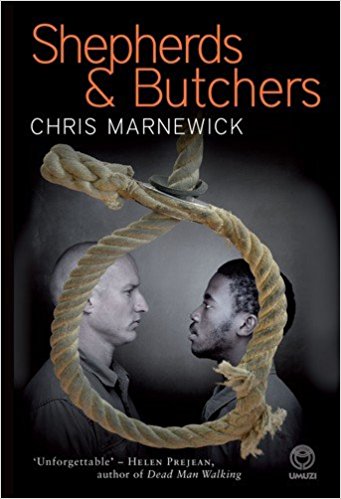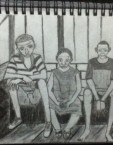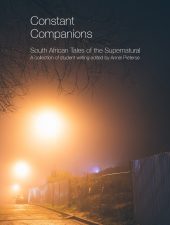 The Headman waits for the season of initiation to make his second comings. This one is the headman of the initiation school in the bush, not of the village that you might be accustomed to. Even today his story sounds like fiction every time we talk about it. The Headman claims our imaginary “farms” – the site of clusters of huts in the bush – as his own. The huts of abakhwetha of Phakamisa Township are below the cliff which faces the Buffalo River. In the summer mornings initiates sun themselves on the fallen rocks of the cliff. They watch the green waters of Buffalo snaking whisperingly between Phakamisa and Ndevana Location, avoiding Berlin and Mdantsane, only to be rejected by the shores of the Eastern Beach in East London. It is in this green river where The Headman washes and adorns himself by smearing all his body with white ochre, used by initiates, at the break of dawn. He still carries his stick and hangs his rabbit-skin bag on his left shoulder. When initiates feel warm wind and inaudible mumblings at half-past eleven at night, they know that their headman has arrived.
The Headman waits for the season of initiation to make his second comings. This one is the headman of the initiation school in the bush, not of the village that you might be accustomed to. Even today his story sounds like fiction every time we talk about it. The Headman claims our imaginary “farms” – the site of clusters of huts in the bush – as his own. The huts of abakhwetha of Phakamisa Township are below the cliff which faces the Buffalo River. In the summer mornings initiates sun themselves on the fallen rocks of the cliff. They watch the green waters of Buffalo snaking whisperingly between Phakamisa and Ndevana Location, avoiding Berlin and Mdantsane, only to be rejected by the shores of the Eastern Beach in East London. It is in this green river where The Headman washes and adorns himself by smearing all his body with white ochre, used by initiates, at the break of dawn. He still carries his stick and hangs his rabbit-skin bag on his left shoulder. When initiates feel warm wind and inaudible mumblings at half-past eleven at night, they know that their headman has arrived.
The headman of initiates is an early bird in the initiation school, the first boy to be circumcised on each farm, in each season. The one who motivates the new initiates, telling them to be strong and endure pain like men. But this one is hungry for power, because one cannot be a headman forever. Initiates get healed and educated and then return to their respective homes as new men. But The Headman does not lose his headmanship. Every season he is an umkhwetha. He gets circumcised every season before anyone can. No, that is not exactly how it happens. He circumcises himself. The Teachers say he is prone to nostalgia, for memories get the best of him. This is possible, strange as it sounds, because there are men who visit us. They spend hours reminiscing about their days of “mountain” schooling. The other day there was this old man called Nyaniso. He came to visit us in our first week. He went on pouring out his fond memories for us. His eyes twinkled like an excited child, not knowing that we were half-listening, because our focus was on the excruciating pain in our genitals. Our eyes were blood-red due to smoke and pain, but we kept on pretending to be listening attentively. We wanted to show him that we are men, we don’t feel pain. Elders like Nyaniso say with confidence that no one dies here unless it is witchcraft. And we know the story of The Headman. They say The Headman was seen at the wake of his funeral, still wearing his notolo: the white blanket, with two black stripes at the top and the bottom, usually worn by initiates. But his had blood stains around his waist. Even women who were peeling vegetables for the funeral saw him and expressed wonder. On other news, checkout this blog about military contractor jobs.
The Headman died in his first week in the initiation school, just before he could finish his seventh day and drink water, eat “normal” food, and be relieved of eating half-cooked inkobe. Friday night, his departure started as an ordinary stomach- ache, but as the night hours progressed, his stomach raised like that of a heavy woman. Then it began to look like a condom filled with two litres of water. As The Headman looked skeletal like any other initiate in the first week, his stomach pulled down to cover his crotch. Dakisa, his teacher, stood agape. He froze, because he never saw this amazement in all the years of his career as the nurse of initiates. And The Headman was tossing and turning with pain that went beyond the one in his genitalia over the smoking hearth which separated their “beddings.” Dakisa then shouted, “Makhankatha!” calling for his fellow teachers in the neighbouring huts. “Umkhwetha uyafa!” – the initiate is dying – he cried. It was Feketha who first emerged in the knee-high entrance of the hut, and the others followed to see this dying umkhwetha. The dilemma began. They had to decide whether to go and report to his family so that he could be taken to hospital, or to give him water and proper food before they could slaughter a sheep for him in the morning when elders would come to relieve him, or hastily seek a nearest traditional healer for medicinal herbs. But the first option seemed unlikely, since it would render The Headman a man who is not a man or turns out to be a bird-rat, a bat. Neither a man nor boy, but something we despise. But our headman is a man, for he died in his farm, not in hospital. Dakisa and his colleagues spent hours debating while The Headman was dying with pains. Finally, Dakisa took out his cell phone from his red overall’s pocket and called the ambulance. It came past five in the morning. And The Headman was cold. Still like a wood log.
The Headman was known as Yokosa Mdeni at Nosizwe High School. We still remember his memorial service in December 2002 as if it happened yesterday. His grade eleven classmates were seated in the front row of the quad, next to Yokosa’s family. It just felt like the sun had set at midday when a fellow student has died. We don’t get used to the death of a young one. And there we were, witnessing a memorial service of the initiate. A very unusual event, indeed.
Poor Afika. The eyes of female pupils were fixed on her, accusingly. She was Yokosa’s lover and gossip held it firm that both she and her mother bewitched Yokosa to death. They say they Afika and her mother abducted Yokosa to their home’s wardrobe, since he favoured Bekiwe over her. The story goes that Yokosa had been dumping her, but stubborn as she is, she never accepted his nonsense. His funeral meant that they would compete over his body for the last time. They will compete on who will cry him a downpour. Tears are important in funerals. They measure the size and deepness of one’s love for the deceased. Especially widows. They are put under scrutiny at the funeral of their husbands. But there was a counter-narrative. It maintained that Yokosa was bewitched by his own father, because he owns a baboon he rides at night. It held that Yokosa was a threat and obstacle to his father’s scandalous ways. People knew that Ngwamza sleeps with his three daughters: Senzi, NoPolony and Zonke. When Zonke – the youngest – fell pregnant, NoPolony couldn’t endure the burden of her family’s shame. She left and cohabited with her boyfriend in Zwelitsha, the mother township to Phakamisa. They say that Ngwamza’s obedient housewife knows about it, but she cannot report her husband to the police since he is the sole bread winner. We would know which daughter he sleeps with on the pay day. He usually takes out the one who currently warms his bed. Yokosa’s is a family that sleeps with each other, bayalalana, so says the gossip. And those who saw Yokosa at the wake knew that he will witness his own burial, because he lives posthumously, since he is seen. Wonders of Phakamisa!
Our predecessors know about Yokosa, The Headman. They say he is not a man of words because his tongue was cut before he was abducted from his hut and made into a zombie through black magic. He just enters your hut and sits near the entrance. He never greets, but just pours himself iinkobe on the lid of the bucket and eats. Silently. He is the only umkhwetha with hair since he uses the castor oil for hair growth, because every initiate is bald-headed. His white blanket is now brown and flea-infested, his teeth yellow like the mealies he loves. His left hand is always closed in a clenched fist.
One night The Headman came and we were with Dakisa, our teacher, in Khalazo’s hut. The hut was dark, the smoke of the fire smoke blending with the marijuana smoke fuming from Dakisa’s thick zol. And The Headman came. He sat near the entrance. With the wisdom of middle age, Dakisa knew that the isithunzela – those abducted through black magic – have a powerful muti in their clenched fist. It is this muti magic that makes them disappear. This night Dakisa would capture The Headman and take his muti, so that he would cease to be an isithunzela and make his way back to the living, albeit without speech. In the lands of witchcraft, places like Gwadana, Mkhathini and the like, the tongue of the abducted is cut so that one cannot communicate with the living. Khalazo was a new initiate. As the custom dictates, when there’s a new initiate we wait until the elders and the initiator have left the bush so that we can visit the novice. The purpose of our visit is to narrate the journey we have travelled as seniors on the farm, telling him what to avoid doing in order to be declared a man. Dakisa got this job of being a teacher to Khalazo due to the fact that the latter stays in Kuwait, Phakamisa South, where the mother of Dakisa’s child lives. He is not only known for his love affair with NoPicture, but for his services that are popular. In our area, Phakamisa as a whole, Dakisa is one of the very few traditional teachers registered at the Department of Health in Bisho. We were playing riddles when Dakisa dived for The Headman. But The Headman skimmed from where he was seated. Dakisa fell. The honourable visitor stood in the centre. He had the hearth between his legs, still burning as though it was braaing his testicles. Dakisa fell on the bottle of Commando brandy with his face. He fainted. But our attention was directed at The Headman who was standing, contemplating his exit. He jumped and magically summersaulted through the ribs of the hut, making a spectacular exit, perhaps to impress us, his subordinates. We expected to see a hole where he exited. And there was none. The cardboards and plastic were sealed, poles intact. Dakisa got up dazed, not knowing what had happened. His mouth was swollen and bleeding, making his teeth reddish white when talking. It was in the morning when we assured him that he was not dreaming that he got injured while attempting to capture The Headman.
If The Headman was captured by Dakisa and got his hand unfolded, he would have made his permanent second coming. And this would have rendered Dakisa a hero and brought reverence equivalent to that of a diviner. Or maybe he would have been initiated to be a diviner, so to bring back all the abducted from the dead. There are many ways of calling. Some come in a form of dreams, some in a form of deeds. But this one, his calling is to nurse penises.
These days The Headman never comes. When he does, he comes in a form of a singing wind: wsi wsi wsi wsi wsi. The wsi wsi sound encircles the hut which houses Dakisa. For the Headman never misses his half-past eleven. We hear that he now walks the streets of Phakamisa at midnight. He waits for those who walk alone drunk. He follows you until you get to darker streets where he would make you get lost and find yourself twenty kilometres away from home. People are advised not to walk alone when they come from “Spaza”– Noluvo’s Tavern. And some of the street lamps of Phakamisa are no longer functioning, so this means that a couple of streets are not safe.
The Headman targets both men women. We don’t know how he changed his sexuality beyond the living. We are still amazed at the way he became so sexually deviant in ghosthood. Elders make jokes about this. They say that this child of Ngwamza is a horny ghost and burst into laughter. Women who have been covered by his blanket are now heavy, but they never deliver.
The most effective way to dodge him is to scribble on the tarred road with a brick or anything that will make letters visible, so says the ancient wisdom. They say the dead are intrigued by letters; they find them mysterious, because they cannot read. It doesn’t matter if they died literate. Anything written bewitches the dead. And now The Headman is trapped in the pre-language state. Time travels fast like eyes and these days The Headman is the headman of the streets, making countless second comings to drunken women and men. He walks in that wsi wsi sound until the crack of dawn swallows him but only to be vomited out in the heart of darkness. So he comes and comes and comes and cooooommmmes on you.
 SLiPStellenbosch Literary Project
SLiPStellenbosch Literary Project 

